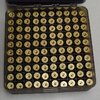It’s well documented why and how impact likelihood is improved when shooting 6.5 creedmoor - a lighter, faster load, with higher ballistic coefficient - than 308winchester. Read Litz’s work, and the PRB article in which the WEZ model is used (a Monte Carlo simulator) to produce a predictive hit percentage model, and the corresponding sensitivity analysis. The answer is clear, a 308win is never a better choice for 1,000yrd shooting than a 6.5 creedmoor.
Sensitivity becomes key at long range. A faster, higher ballistic coefficient bullet will be less sensitive to variability. Wind and range estimation errors (even when ranged with a laser) will influence a slower OR less aerodynamic bullet more than they will influence a faster or more aerodynamic bullet.
Here’s an example of a sensitivity analysis done by PRB, reflecting various combinations, a matrix, of large and small bullets and fast and slow bullets. Not well described, but certainly demonstrated is the overall, simple trend: the faster a bullet is going with a higher BC, the less sensitive it will be, such the greater its hit probability will be.
View attachment 924462
You’ve broadly over-generalized the craft of long range shooting. You are not always forced to choose a fast, low BC bullet against a slow, high BC bullet - it’s a two dimensional system which encompasses a planar spectrum of cartridges - light and slow, heavy and slow, light and fast, heavy and fast, and everything in between. Increasing caliber is one way to increase ballistic coefficient, but only when the bullet weight is proportionately increased to maintain an appropriate bullet profile (form factor) and when the powder charge is commensurately increased also to maintain velocity.
In competition, almost unilaterally, recoil is bad. So increasing bullet weight, and correspondingly increasing charge weight to achieve velocity is almost unilaterally bad. A shooter has to have a REALLY good reason to tolerate recoil.
Sometimes we need to kill game at long range, so we need a lot more powder to deliver a heavier payload at a higher velocity downrange. And we tolerate a lot more recoil. That’s an entirely different ball of wax. We need a bigger bullet and more powder - which almost always comes with disadvantageous baggage.
Having said all of that, confirming that it is GENERALLY true to say “you can’t outrun efficiency,” but it happens very frequently that a slightly less aerodynamic bullet can be pushed sufficiently fast to defy that logic. For example, at EVERY. SINGLE. MATCH. I will overhear a couple 6.5 creed shooters discussing a certain target, because their wind bracket is larger than the target, so they have to pick their bracket more carefully and risk missing upwind OR downwind if they are wrong. So I check my data - nope, my bracket is still smaller than the target, and I smile. I drop less points than they do because my 6 creed shoots faster (3100 vs. 2800), and still has a very respectable BC (.275 vs. .310). So I can literally outrun their bullet to the target just enough to defy the wind, and not give up increased risk in my wind call.





